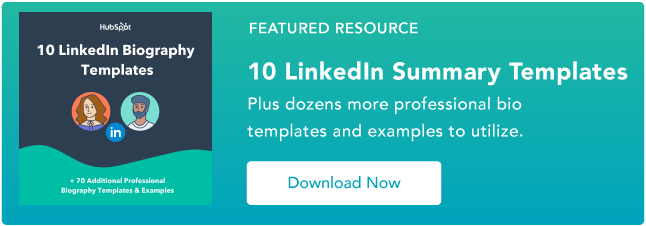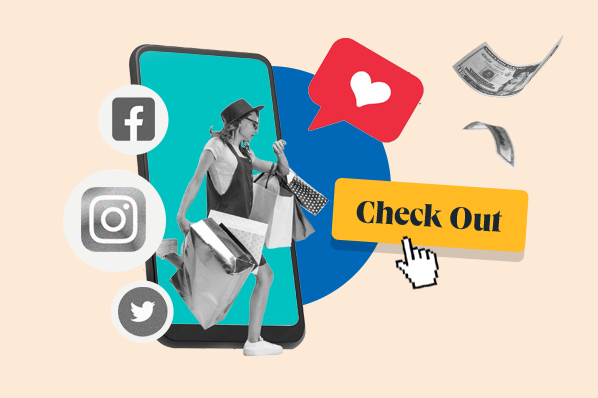Everyone who's active online has some sort of personal brand established. Social media accounts, websites, digital portfolios, blog articles, and the various ways you communicate all contribute to your unique identity and image.
.jpg?width=595&height=400&name=Personal%20Branding%20%281%29.jpg)
Unaware of your personal brand? Take a few seconds to Google yourself. Whatever content mentions you is part of your brand.
There’s no denying the benefits of branding. Research by McKinsey found that strong brands outperform their less recognizable competitors by as much as 73%. And since 64% of today’s customers are belief-driven buyers, they want to support brands that “can be a powerful force for change."
Personal branding comes with similar benefits as company branding. It helps you connect with customers, become more visible in your industry, shape your reputation, leave a lasting impression during online and in-person networking, and sell more to target prospects.
This guide shares the essential components of a strong individual brand, top personal branding examples, and tips for creating a memorable personal brand.
.webp)
80+ Professional Bio Templates & Examples
Create a compelling professional narrative for a proper, attention-grabbing introduction.
- LinkedIn Summaries
- Speaker Intros
- Website Bios
- Professional Profile
What is personal branding?
Personal branding is the projected image of an individual's personality, skills, experience, and behavior that defines their unique identity.
Creating a defined personal brand is a great way to distinguish yourself in today's competitive market because it lets people understand who you are, even when you're not in the room. You set yourself apart by telling your story, sharing your personality, and connecting with people who vibe with your vision.
Personal branding includes all content that's available about a person. It's simple to build from scratch but difficult to change once an identity is set. Imagine if Elon Musk started sharing inspirational tweets full of empathy and emotional intelligence. His followers would be confused because the messages diverge so much from his well-defined personal brand of brash intelligence and risk-taking bravado.
Many people focus on being themselves when starting to build their personal brands, but a brand isn't something that simply develops organically. Like a company brand, it has to be maintained to appear consistent and cohesive. Creating boundaries around your brand is the best way to ensure everyone knows what you stand for and how you present yourself.
Yes, personal branding takes time and work to get right. Yet it's worth the effort if you want to create a persona that attracts people to your inbox.
Why is personal branding important?
Setting aside time to cultivate a personal brand has several benefits for both you and your customers.
People will quickly decide if they want to work with you.
A sparse or generic LinkedIn profile doesn't instill a sense of familiarity and trust in potential buyers. Instead, they're left with more questions than answers.
- Is this a person I can depend on?
- Will they be willing to work with me in the way I prefer?
- What's their take on current industry issues?
- How can they help me improve my business?
By openly communicating your viewpoint for the world to see, prospects who stop by your social pages can easily decide if they can envision themselves working with you or not.
You'll easily differentiate yourself from competitors.
If you take the time to define and reinforce your personal brand, your online presence will appear cohesive and consistent. This helps you stand out from competitors who don't maintain a strong persona or who present a vastly different one. Anyone visiting your profile or Googling your name immediately knows what you stand for and feels like they know you on a personal level.
You'll be set to start your own business.
If you have entrepreneurial aspirations, a strong personal brand will make the transition to a business owner that much easier. Differentiation is half the battle with a new product or service, and people often associate a start-up with its founder. The more definitively you can brand yourself, the better.
You'll increase your authenticity and, ultimately, sell more.
According to sales expert and author Jill Konrath, the rep is the primary differentiator in sales today. No matter what they're buying, prospects know they can get a similar product or service from another vendor. What they can't get from just any provider is the same sales experience with the same salesperson. And since consumers are twice as likely to say user-generated content is more authentic than brand-created content, they're looking for people who create content that's representative of a person, rather than a company.
By presenting a distinct personal brand, you'll make it easier for your buyers to choose your company (and you) over another vendor.
5 Personal Branding Essentials
So you've set aside some time to work on personal branding. Where to start? Here are the five essential components of an effective personal brand.
1. A complete LinkedIn profile.
LinkedIn is at the crux of your personal brand. Your target audience will research you on the network before deciding to work with, hire, or refer you. So it's crucial to fill out your profile and make it compelling.
Pressed for time? Address these key areas before anything else:
- Choose your picture deliberately. A high-quality, professional picture is a must-have. Depending on how you're trying to differentiate yourself, choose a picture that shows you in a certain light. Seeking a training gig? Post a picture of you speaking or teaching others. Attempting to attract buyers in a buttoned-up industry? A suit, tie, and direct, confident gaze will do the trick. Your profile photo is the first glance people have of your personal brand, so make sure it gives the right appearance.
- Optimize your headline. Don't just list your title and company. Consider using your positioning statement as your headline or trying out these headline tips from job search expert, Jenny Foss.
- Enhance your summary. Aim for three paragraphs with no more than three sentences each. Emphasize the results you've helped drive either for your company or clients, what separates you from others in your profession or industry, and the things you're passionate about. Make sure to include contact information in the final paragraph and consider adding a gentle call to action (i.e "Follow me on Twitter" or "Visit my website to learn more").
- Feature visual content. Whether you create content or curate it, you should include eye-catching visual content in your gallery that will interest your target audience. Select pieces that reinforce the vision set out in your positioning statement. For example, if you are a firm believer in the power of recruiting technology to source high-quality candidates, post a SlideShare or infographic on the topic.
If you need a full profile makeover, check out this guide to optimizing your LinkedIn page.
.webp)
80+ Professional Bio Templates & Examples
Create a compelling professional narrative for a proper, attention-grabbing introduction.
- LinkedIn Summaries
- Speaker Intros
- Website Bios
- Professional Profile
2. A positioning statement.
If you're in sales, you're no stranger to positioning statements. Smart reps always have a succinct statement on hand about their product or service to combat the inevitable "What is this about, anyway?" buyer brush-off. A personal positioning statement should answer the slightly amended question "What are you about, anyway?"
When crafting a personal positioning statement, keep your target audience in mind. Your value proposition might be about you but it's not for you. Express to your target audience what makes you different from others in your industry, profession, or role. If you're not sure what makes you different, spend some time researching your peers and reflecting on your individual beliefs and passions.
Consider these LinkedIn personal branding statement examples from influential leaders:
Sara Blakely: Founder of SPANX, who has nearly 1.6 million followers.
I am the founder and CEO of SPANX! I started SPANX in 2000 with $5,000 in personal savings and I’ve never taken any outside investments. I am a big believer in following your instincts and taking unique approaches to business.
Richard Branson: Founder of Virgin Group, who has over 19 million followers.
Founder of the Virgin Group, which has gone on to grow successful businesses in sectors including mobile telephony, travel and transportation, financial services, leisure and entertainment and health and wellness. I'm a tie-loathing adventurer, philanthropist and troublemaker, who believes in turning ideas into reality. Otherwise known as Dr Yes!
In terms of format and structure, stick to these guidelines:
- Shorter is better. A few concise sentences are ideal.
- Instead of using nouns to explain what you do (title at company), use verbs to illustrate how you do it.
- Avoid overused words such as "motivated," "strategic," and "driven."
- Avoid industry jargon and acronyms.
3. An SEO-friendly profile.
Equally important as defining and capturing what makes you different is ensuring that you can be easily found online. After all, there's not much point in writing a positioning statement if no one reads it.
For this reason, cursory keyword research is an essential part of any personal branding initiative. Again, instead of thinking about the keywords you most associate with yourself, think about the words or phrases your target audience might search for to find someone like you. Keyword phrases could be industry-related ("human resources"), role-related ("talent acquisition manager"), or results-related ("cut hiring costs"). If you're struggling to think of keywords, check out the free app Keyword Tool.io for inspiration.
Once you've decided on a keyword or two, insert them into your LinkedIn profile, Twitter bio, blog, resume, website, and any other online or social media spaces you're involved in. Just make sure to do so naturally. Inserting a nonsensical sentence chock full of keywords onto a web page is called keyword stuffing and will send you to the bottom of Google in a hurry. A good rule of thumb is to include your keyword in your LinkedIn header and two to three times in the "About" section.
4. A unique point of view.
What you say and how you say it defines your personal brand. If you sound and look just like everyone else, your branding won't stand out—and it definitely won't be memorable. That's why it's crucial to develop a voice that sounds like you and shares your unique opinions.
To understand what point of view you have to offer, ask yourself the following questions:
- How would I describe myself in 3-5 words?
- Is my tone formal or casual?
- Do I use certain words or avoid certain words (ie. swear words or industry jargon)?
- What do I do better than anyone else?
- What value can I offer to my community/industry/network?
To help, you can try honing in on your personal brand with our free persona tool.
When you know what sets you apart, you'll be able to create posts and articles that share your point of view and build your personal brand.
5. A consistent posting schedule.
Once your profile is optimized and your point of view defined, it's time to start posting.
One of the best ways to explain how your approach differs from your peers' is to write it down for all to see. Use LinkedIn status updates to share your thoughts on an industry or workplace trend, or write an article about a new product you're selling, your most helpful sales tactics, or how you got started in your industry.
While your posts shouldn't be blatant self-advertisement, you can use your LinkedIn as a personal branding vehicle by taking the right angle. Make sure each post adds to the larger conversation while differentiating your point of view from others.
Here are a few article examples:
- Everyone's Saying X about Trend Y. Here's Why I Disagree
- Y Mistakes Most Professionals Make When Doing Z
- The Unique Way I'm Planning to Address X at My Organization
First-time writer? No problem. Check out these free HubSpot blog post templates to get off on the right foot.
While it's important to share your thoughts through posts and articles, it's also essential to be consistent. Posting three times per week for a month, and then stopping for two months, hurts your credibility and growth. It's better to develop a habit you can maintain, like posting twice per month, than pushing out a mass amount of content before going cold for a long period of time.
Figure out a posting schedule that works for you, and stick to it.
Personal Branding Strategy
It can be tough to draw the line between "not enough" and "too much" when it comes to personal branding. Let's dive into the steps to develop a strategy that will set your brand apart from the rest.
.webp)
80+ Professional Bio Templates & Examples
Create a compelling professional narrative for a proper, attention-grabbing introduction.
- LinkedIn Summaries
- Speaker Intros
- Website Bios
- Professional Profile
Define your goals.
Why do you want a personal brand? Think over this answer before you dedicate time to crafting your image and creating content.
Maybe you want to work your way up to an executive role. Maybe you're a leader and want to share your thoughts and tactics with the world. Maybe you were asked to be a spokesperson for your company, or maybe you want to start your own company.
Whatever the reason, write down three to five goals you hope to achieve by having a personal brand. This will help define your content strategy and encourage you to continue when you (inevitably) don't feel like posting one day.
Create a unified theme.
Coca-Cola is known for its unique bottle and red color scheme. Disney projects a feeling of magic and dreams come true. Personal branding also requires a unified theme to make you instantly recognizable.
You can create a consistent theme by considering all the factors that make up a brand's visual identity. Fonts, logos, colors, images, and messaging should be the same across your social accounts, website, portfolio, blog, or other channels.
Here are a few examples of consistent personal branding themes:


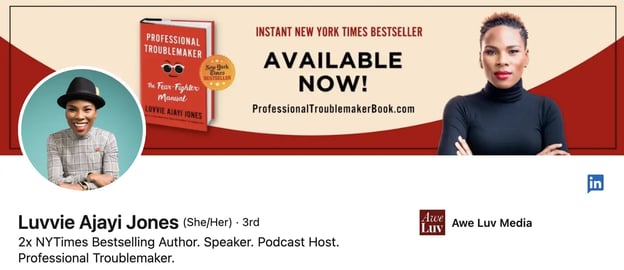
Tell your story.
People want to connect with people, not companies. Personal branding helps you show others what makes you tick by highlighting your personality, opinions, work, skills, and quirks. To tell your story, you can write a post about why you chose to pursue your career, make a video about the top lessons you've learned in your role, share what events inspired you to work at your company, or talk about your personal connection to the products or services you sell.
Check out how Sara Blakely shares a part of her story.
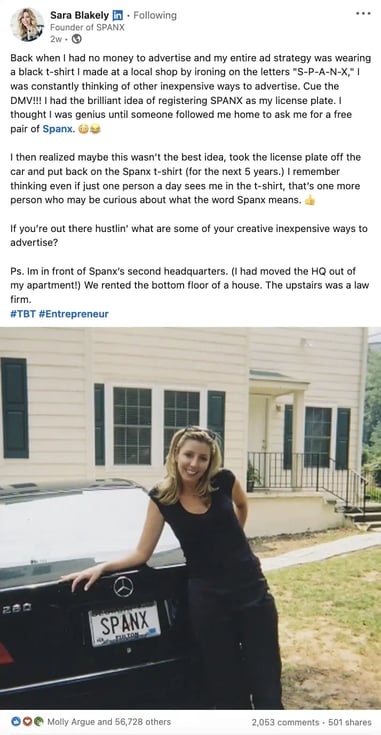
Stay human.
Sharing your story is only one piece of the personal branding puzzle. As your brand grows, you have to remember that you're a person, not a brand. Never refer to yourself as a brand (that's cringe-worthy), or bad-mouth competitors (focus on what you do instead).
While you may want your personal brand to be all about business, it's beneficial to show your human side from time to time. Mention your customers, colleagues, or work relationships. Share content from leaders you admire and people in your network. By posting content that's not always buttoned-up, you give people a look at who you are—a person trying to connect with other people.
Personal Branding Examples
Need some personal branding inspiration? Look no further than the following professionals.
1. Katie Burke
Katie, the Chief People Officer of HubSpot, is incredibly active on LinkedIn. Not only does she share her own content, like when she's invited to speak at industry webinars, but she also consistently engages with HubSpot employees and customers. By sharing other people's posts and celebrating their wins, she reinforces her role as a leader and builds her personal brand.
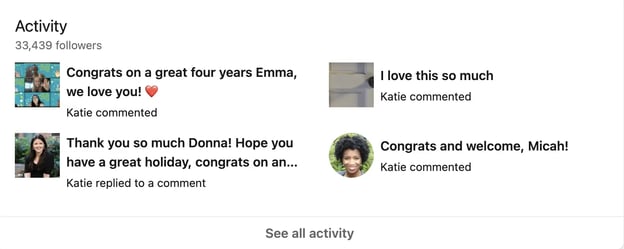
2. Liz Ryan
With over three million followers on LinkedIn, Liz built a personal brand around providing helpful HR advice to job seekers and leaders. Her posts focus on advising her audience and gathering insights, which draws people looking for career advice or a coach—and to her books and business. But even if you don't buy, she still provides extremely valuable advice to her followers.
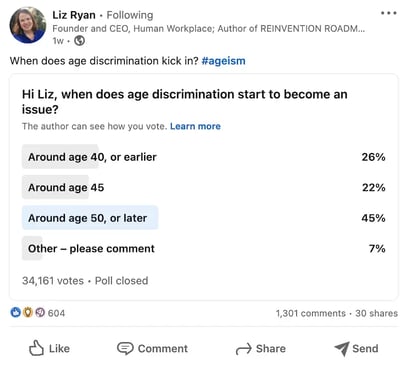
3. Cristina Mittermeier
Cristina is a marine biologist, photographer, and the founder of the ocean conservation organization SeaLegacy. Her personal brand highlights her abilities as a scientist and educates people on conservation through visual storytelling. She shares relevant articles, podcasts, images, and campaigns that interest her followers to raise awareness for the various causes she supports.
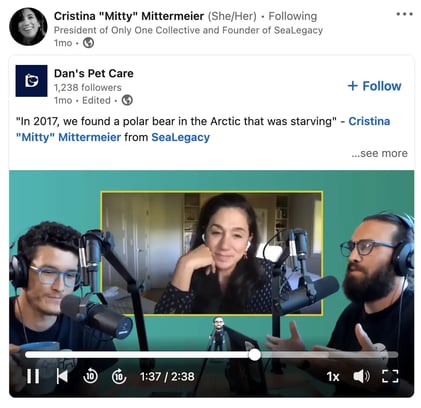
Personal Branding Resources
Creating a strong personal brand requires getting to know yourself and putting in the work to create consistent, unique content. These free personal branding resources can help you get started, with templates for writing a professional bio, defining goals, and so much more.
You'll know you've developed a brand that's recognizable, memorable, and unique when people say, "Oh, I've heard of you. You're the [insert what sets you apart] person."
Editor's note: This post was originally published on June 8, 2015 and has been updated for comprehensiveness.

